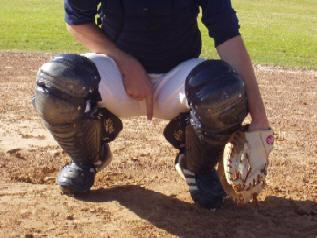Yesterday’s post was about catchers giving signals during throwing sessions. I thought I’d give a few options for catchers when it comes to giving signs.
The options below are generally done when there is a runner at second base. You mix the signs up so that

Not too obvious. Not too complicated.
the runner will not know what the pitch will be and therefore cannot relay the info to the hitter or use it to help him time a steal of third base.
When coming up with your mix of signals, you want them to be tough to decipher but not too complicated for your own guys. There are many complicated methods of giving signs but sometimes they do more harm then good. Pitchers and middle infielders have enough on their minds already. They don’t need complicated signs taking up a lot of brain space.
Below are a few options ranging from basic to advanced. There are certainly others so feel free to make up your own as needed.
Basic:
First sign / Second sign / Last sign – Pretty simple. The catcher’s first sign, second sign, or last sign in the sequence is the pitch. If it is the second or last sign and the pitcher shakes him off, it usually switches to the first sign after that to confuse the runner and quicken the process.
Intermediate:
First sign after two – The catcher gives a few signs but the pitch he wants is the next sign after he puts down two fingers. Example: 1-3-2-1-3 would be a fastball since the 1 (fastball) appeared after the 2. 2-2-1-3 would be a curveball or whatever else two fingers meant. Whatever number is flashed after the first 2 is the pitch.
Pumps – In this example, it doesn’t matter what fingers the catcher puts down. The pitcher just counts the pumps or how many times the catcher puts fingers down. Example: 2-1-3 would be three “pumps.” Three could mean a slider or maybe something else. This is where it gets tricky if you are a bit older – high school and up. Put one pump down for a fastball and the runner will quickly figure out what you are doing – which is “pumps.” To get around this, let’s say I throw three pitches – a fastball, a slider, and a change-up. Pump #1 = fastball, Pump #2 = slider, Pump #3 = change-up, and Pump #4 = fastball again! Adding one extra pump and making that a fastball too works well. Know your pitchers though. Some pitchers get so worked up on the mound that a simple counting exercise becomes difficult. Match the signal option to the needs of the pitcher.
Touches – This is similar to the first sign/last sign option but instead of putting fingers down, the catcher touches parts of his body like a coach would in the third base coaching box. This one is good during low light conditions or when night-game lights create shadows making it tough for pitchers and middle infielders to see the signs flashed in the normal location. Click HERE for another option in low-light conditions. I’ve seen some pitchers (Jamie Moyer comes to mind) who will make this system more complicated by doing both signs and touches – the sign for the pitch and the touch for the location or vice versa. I think this is a bit too complicated but if it works, go for it.
Advanced:
Indicator plus pumps – Let’s say a pitcher has four pitches – fastball, curve, slider, change-up. Like before, you make the fifth pitch another fastball so it’s now 1=fastball, 2=curve, 3=slider, 4=change-up, 5=fastball. For this sequence, the catcher’s first sign is the indicator that tells the pitcher which number to start with in the sequence. If his first sign is three fingers then each pump after that adds to the three. Example: 2 – 1 – 3 would be a change-up because the catcher started with #2 and then added two more pumps after that. 2 + 2 = 4 (change-up). 3 – 2 – 3 – 2 would be a fastball because the first sign started at #3. Three pumps took it back to #1 which is a fastball. Pop-Quiz: what is 1 – 3 – 1? If you said slider, you are correct. #1 was the indicator and two more pumps took it to #3 (1+2=3) which is a slider.
Sign / Pump mix – The Sign / Pump Mix are the same as before but in this option, which one you use depends on the inning. Odd numbered innings might require a simple sign (first sign, second sign, etc.) and even numbered innings use the pump option. I’m not a big fan of this one either but again, to each his own.
One final note. Just because you are at the high school, college, or professional level doesn’t mean you have to use the more advanced options. If you pay attention to those who might be stealing signs and change them up according, keeping things relatively simple is usually best.
Next post: Product review: The Three Piece Tee

